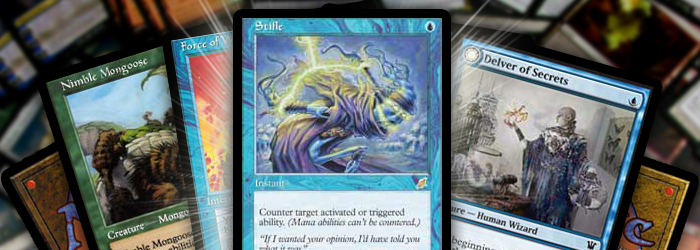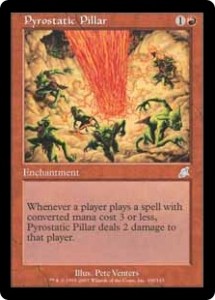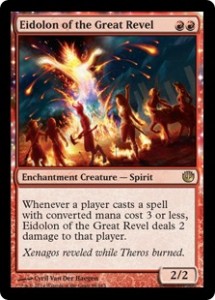
Welcome back to Learning Legacy, brewers. I received a positive response to the “You Can Stifle That?” section I’ve included in some of these articles. Several people have commented and even suggested interactions to talk about. The suggestions, as well as a specific interaction of my own at a high-level tournament, sparked an idea.
Welcome to…
You Probably Shouldn’t [card]Stifle[/card] That
This article is all about interactions that come up that you might be tempted to respond with a [card]Stifle[/card] but really shouldn’t. Just don’t do it. Just because a trigger happens in Magic, it does not mean you need to tap your blue mana and counter it. You may be asking, “I love to counter things, so why shouldn’t I counter this trigger? After all, triggered abilities don’t always occur.”
Today, we will look at situations that can happen in Legacy where your [card]Stifle[/card] does not really do what you want it to do (at least from a RUG Delver perspective). There are times when your stifle will do nothing even when you think it is doing something. We will start out easy and progressively and move too less obvious examples. Keep in mind that all of these examples may seem fairly obvious now, but trust me: when you’re grinding Legacy all day and your brain is tired and you’re close to making a top eight and you just need this one more win, casting [card]Stifle[/card] in these situations may seem like a good idea.

[card]Vexing Devil[/card]
You’re playing against a mono-red opponent. You have had Stifle stuck in your hand for a few turns and you quickly realize that their deck doesn’t have that many targets. You get frustrated with the dead card in hand until your opponent plays [card]Vexing Devil[/card]. You smile as your opponent puts the triggered ability on the stack. Do you [card]Stifle[/card] it?
NO. Stifling this ability actual does nothing. It’s the same as not paying four life, which keeps the creature in play. You’re better off saving that [card]Stifle[/card] to put back with a [card]Brainstorm[/card].
[card]Eidolon of the Great Revel[/card] / [card]Pyrostatic Pillar[/card]
We’re still playing against our mono-red opponent. It’s game two and our opening hand again has a [card]Stifle[/card]. Ugh. Anyway, a few turns progress and our opponent resolves an [card]Eidolon of the Great Revel[/card]. We want to resolve our [card]Tarmogoyf[/card] but not take too much damage. Luckily, we have [card]Stifle[/card].
WAIT. Don’t [card]Stifle[/card] the Eidolon trigger when you play the [card]Tarmogoyf[/card]. The [card]Stifle[/card] will counter the original trigger, sure, but by playing the [card]Stifle[/card], the Eidolon will trigger again. The net exchange from this play is a resolved [card]Tarmogoyf[/card], a discarded [card]Stifle[/card], and you still taking the damage. As a RUG player, it is much better to not let these cards resolve at all. Our whole deck is basically ones and twos.
[card]Standstill[/card]
All right, we won against our Burn opponent. Onto the next round. This time, we are facing a blue deck, and unfortunately, they have played and resolved a [card]Standstill[/card]. We know we need to break it and let our opponent draw three cards sooner or later. We untap and draw [card]Stifle[/card]. The plan is to play our Goyf and then we can counter the [card]Standstill[/card] trigger with our [card]Stifle[/card].
DON’T. This example is similar to the one above. When we play the Goyf, the [card]Standstill[/card] will trigger. If we cast [card]Stifle[/card] to counter the trigger, we will again be triggering the [card]Standstill[/card], which will let our opponent draw the cards anyway. Again, this seems intuitive now, but it’s easy to forget in an actual game.
[card]Counterbalance[/card]
Our [card]Tarmogoyf[/card] went the distance and we were able to win the last round too. We’re 2-0 and playing against a more established popular deck, UW Miracles. We got our opponent down to two life, but things are not looking good. There is a [card]Counterbalance[/card] on the board. We have [card]Lightning Bolt[/card] and Stifle in hand. We think to ourselves that we can [card]Lightning Bolt[/card] the opponent’s face while he’s tapped out and then [card]Stifle[/card] the [card]Counterbalance[/card] trigger.
STOP. While there may be a small percentage of the time that Stifling the [card]Counterbalance[/card] trigger is correct, this situation is not one of them. When we cast Bolt, the enchantment will trigger. If a one-drop is revealed, it will counter the Bolt. If we try to [card]Stifle[/card] the trigger, it will trigger again, and that same one-drop will counter the [card]Stifle[/card] and then the other trigger will resolve countering the Bolt.
[card]Thespian’s Stage[/card]-[card]Dark Depths[/card] Combo
So we lost the last game but went on to win the match. Way to go, us. We now are playing against a new opponent who is playing Lands. She has assembled the combo of [card]Dark Depths[/card] and [card]Thespian’s Stage[/card] and is threatening to make a 20/20 indestructible Gerry Thompson unless we stop her with our [card]Stifle[/card]. When she goes to copy the Dark Depths, which will make her sacrifice the original, we will [card]Stifle[/card] the triggered ability that makes her sacrifice the new [card]Dark Depths[/card] ([card]Thespian’s Stage[/card]) and she will end up with nothing. This plan will totally work, right?
YES.
Just kidding. No. This interaction is quite tricky, and in fact, I lost a game at an SCG Open because I did just what was described above and found out from the judge that it doesn’t work that way. The trigger will go on the stack, but if you [card]Stifle[/card] it, it won’t be sacrificed. It will then continue to have zero counters and trigger again. The best thing you can do is go back to when she activates the [card]Thespian’s Stage[/card] targeting the [card]Dark Depths[/card] and counter that. It won’t permanently solve the problem, but it will buy you another turn.
Well, there you go. You managed to go 3-1 successfully piloting your [card]Stifle[/card] deck. I hope you enjoyed the different approach this time. If you have any suggestions for a topic you want covered, feel free to leave it in the comments.
You Can Stifle That?
Did you know that you can [card]Stifle[/card] ninjitsu? Ninjitsu is an activated ability, so if you choose to [card]Stifle[/card] it, the creature is returned, the ninja is revealed, but the card will not go into play. That’s a pretty awesome tempo advantage against any [card]Ninja of the Deep Hours[/card] decks you may play against.
Thanks for reading.
3 comments on Learning Legacy – You Probably Shouldn’t Stifle That
Leave a Reply to mstrhair Cancel reply
You must be logged in to post a comment.







Except for the Pyrostatic Pillar trap — I was not aware of these. Thank you for this article!
I don’t understand the example with goyf. If I cast goyf and he sacs standstill to draw 3, how will casting stifle targeting that ability trigger standstill? Standstill had to be sacrificed to get the trigger, so it isn’t on board to see me cast stifle. Explain.
The trigger for Standstill will go on the stack while Standstill is in play. When Standstill triggers, it isn’t sacrificed until the ability resolves.